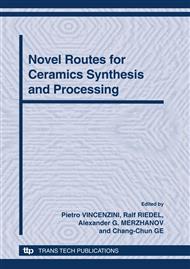[1]
Handbook of Sol-Gel Science and Technology: Processing, Characterization, and Aplications, edited by S. Sakka Publications/Kluwer Academic Publishers, New-York (2004), Vol. 1-3.
Google Scholar
[2]
O.A. Shilova, S.V. Hashkovsky, L.A. Kuznetsova: J. Sol-Gel Sci. Tech. Vol. 26 (2003), p.687.
Google Scholar
[3]
O.A. Shilova: Advan. Sci. Techn. Vol. 45. (2006), p.793 (Information on http: /www. scientific. net).
Google Scholar
[4]
L.V. Nikolaeva, A.I. Borisenko: J. Non-Crystal. Solids Vol. 82 (1986), p.343.
Google Scholar
[5]
O.A. Shilova, S.V. Hashkovsky, E.V. Tarasyuk, V.V. Shilov, V.V. Shevchenko, Yu.P. Gomza, N.S. Klimenko: J. Sol-Gel Sci. Techn. Vol. 26, No 1-3 (2003), p.1131.
DOI: 10.1023/a:1020723210877
Google Scholar
[6]
O.A. Shilova, E.V. Tarasyuk, V.V. Shevchenko, N.S. Klimenko, T.G. Movchan, S.V. Khashkovskii, V.V. Shilov: Glass Physics and Chemistry (Engl. transl. of Fizika i Khimiya Stekla) Vol. 29, No 4 (2003), pp.378-389.
DOI: 10.1023/a:1025125010618
Google Scholar
[7]
O.A. Shilova, T.V. Khamova, D. Yu. Vlasov, Yu. Ryabusheva, O.V. Frank-Kamenetskaya, A.M. Marugin, V.M. Mikhal'chuk, V. Yu. Dolmatov, in.: Abstracts. The Second Nanotechnology International Forum (Moscow: Rusnano 2009), pp.342-344.
DOI: 10.1134/s0020168512060052
Google Scholar
[8]
S.V. Hashkovsky, Shilova O.A., T.V. Khamova, L.N. Efimova, in: Abstracts. The Second Nanotechnology International Forum (Moscow: Rusnano 2009), pp.333-334.
Google Scholar
[9]
S.V. Hashkovsky, Shilova O.A., Shornikov R.S.: Glass Physics and Chemistry (Engl. transl. of Fizika i Khimiya Stekla) Vol. 36, No 4 (2010), in press.
Google Scholar
[10]
S.V. Hashkovsky, O.A. Shilova, E.V. Tarasyuk, RU Patent 2, 260, 569 (2005).
Google Scholar
[11]
E.V. Tarasyuk, O.A. Shilova, V.A. Dubok, Yu.P. Gomza, A.E. Lapshin, V.I. Kornilova, L.N. Kuzmenko: Glass Physics and Chemistry (Engl. transl. of Fizika i Khimiya Stekla), Vol. 32, No 6 (2006) pp.656-665.
DOI: 10.1134/s1087659606060113
Google Scholar
[12]
S. -C. Park, Y. -M. Kim, Y. -M. Kang, K. -T. Kim, P.S. Lee, J. -Y. Lee: J. Power Sources Vol. 103 (2001), pp.86-92.
Google Scholar
[13]
Jr.W.J. Walker, M.C. Brown, V.R.W. Amarakoon: J. Europ. Ceram. Soc. Vol. 21 (2001), p.2031-(2036).
Google Scholar
[14]
T.V. Khamova, O.A. Shilova, E. V Golikova: Glass Physics and Chemistry (Engl. transl. of Fizika i Khimiya Stekla), Vol. 32, No 4 (2006) pp.615-631.
Google Scholar
[15]
S.V. Hashkovsky, O.A. Shilova, T.V. Khamova, S.S. Reutovich, RU Patent 2, 204, 532. (2003).
Google Scholar


